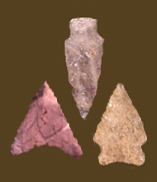
|
PALMER
Chronology The Palmer Corner Notched point dates to the Early Archaic period. Gardner (1989) places the Palmer in his Early Archaic Phase I, 10,000 to 9300 BP (approximately 9500-8600 BC in calendar years), and nine radiocarbon dates associated with type from the Brook Run site in Virginia are between 10,030 and 9390 BP (Voigt 2004). Egloff and McAvoy (1990) place the Palmer point between 9600 and 9200 BP (9000-8400 BC) along Virginia’s Nottoway River. Justice (1987) puts Palmer in the Kirk Corner Notched Cluster dated 9500 to 8900 BP (8800-8100 BC). Steponaitis (1980) assigns an Early Archaic I date of 9500 to 9200 BP (8800-8400 BC) to Palmer points. At the St. Albans site in West Virginia, Broyles (1971) radiocarbon dated the small variety of the Kirk Corner Notched – which some consider to be the same as Palmer – to 6980 +/- 160 BC (approximately 8250 BC in calendar years). In the Northeast, there are some radiocarbon dates suggesting that many Early Archaic point types are as much as 1500-2000 years younger than their equivalents in the Southeast (Funk 1993; Kent 1996). Description Blade: The blade is small and triangular. The sides are usually straight, but occasionally rounded or concave. Most specimens are serrated, some quite deeply. Haft Element: The base is straight and usually exhibits grinding. Size: Length ranges from 28 to 60 mm, with an average of 35 mm. Width ranges from 15 to 25 mm, with an average of 20 mm. Thickness ranges from 5 to 12 mm, with an average of 8 mm. Technique of manufacture: The Palmer was made through bifacial pressure flaking. Parallel flaking patterns are common, often restricted to one face. Occasionally, tear-drop preforms are found. Material: In the area surrounding Zekiah Swamp on the lower Potomac, Wanser (1982) found that 41% of 34 Palmer Corner Notched points were quartzite, with 35% quartz, 21% chert, and 3% other material. Steponaitis (1980) also found a sharp preference for quartzite in the lower Patuxent River drainage, followed by quartz and rhyolite, but the sample was only nine points. Stewart (1980) reported that 92% of 12 Palmers in the Hagerstown Valley were chert or jasper, while 8% were rhyolite. Chert Palmer points predominate in the middle Potomac River Valley, but other local materials are also used (Hranicky 2002). In Western Maryland, local and non-local chert and jasper are commonly used, along with siltstone (Wall 1992). In Delaware, most Palmer points are chert or jasper (Custer 1996a). Discussion Separating Palmer from the Kirk Corner Notched can be problematic (Ward and Davis 1999). Coe (1964) suggests that the Kirk Corner Notched evolved out of the smaller Palmer. Broyles (1971) describes two varieties of the Kirk – an earlier small type and a later large one – and some researchers feel the small variety is the same as the Palmer, without the basal grinding (Justice 1987). Broyles (1971) notes that her large variety – the “classic” Kirk Corner Notched -- sometimes has light basal grinding. Even at the Hardaway site, nearly half of the Kirk Corner Notched points exhibited some degree of basal grinding (Daniel 1998). Because there is some overlap both chronologically and morphologically (including degree of basal grinding) between the Palmer and Kirk corner notched types, Custer (1996a; see also Chapman 1977) suggests it is simpler to combine the two points into one type dated between 10,000 and 9000 BP. Others have stated that Palmers have a tang that is roughly half as long as it is wide (length:width ratio of 0.49), which distinguishes it from more elongated (ratio of 0.65) Kirk tangs (Daniel 1998). McAvoy and McAvoy (1997) defined an earlier form of Palmer – the Deep Notched Palmer – at sites along the Nottoway River in Virginia. The Deep Notched Palmer is a medium point with deep, narrow notches, a straight-to-excurvate base, and often a serrated blade. At the St. Albans site, Broyles (1971) obtained a radiocarbon date of 7900 +/- 500 BC (approximately 9350 BC in calendar years) for a similar point, called Charleston. Benthall (1990) excavated a similar point from the lowest level of the Daugherty Cave site in Virginia, radiocarbon dated to 7840 BC (9300 BC). A slightly later point, the Decatur, is similar in style to, and possibly derived from, the Palmer point. Like the Palmer, the Decatur is a thin, small-to-medium corner notched point with a straight or concave base, and with heavily ground basal margins and corner notches. At the Cactus Hill site in Virginia, McAvoy and McAvoy (1997) obtained a radiocarbon date of 9140 +/- 50 BP (8300 BC) for this type. Although Decatur points are not found in Maryland, they are common in Virginia and to the south. Defined in Literature Other Names Used Kirk Corner Notched (small variety)References |
![]()
Search by Shape:
(See Projectile Point Typology) |

|
Thank you for visiting our website. If you have any
questions, comments, Copyright © 2002 by |

|

 Defining Attributes
Defining Attributes